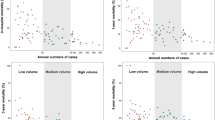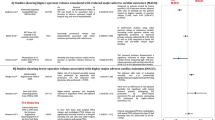Abstract
In-hospital mortality following percutaneous coronary intervention (PCI) varies across institutions with different annual PCI volumes. The failure to rescue (FTR) rate, defined as the mortality rate following PCI-related complications, may account for the volume-outcome relationship. The Japanese Nationwide PCI Registry, a consecutive, nationally mandated registry between 2019 and 2020, was queried. The FTR rate is defined as ‘the number of patients who died following PCI-related complications’ divided by ‘the number of patients who experienced at least one PCI-related complication.’ Multivariate analysis was used to calculate the risk-adjusted odds ratio (aOR) of the FTR rates among hospitals stratified into tertiles as low (≤ 236/year), medium (237–405/year), and high (≥ 406/year). A total of 465,716 PCIs and 1007 institutions were included. A volume-outcome relationship was observed for in-hospital mortality, and the medium-volume (aOR 0.90, 95% confidence interval [CI] 0.85–0.96), as well as high-volume (aOR 0.84, 95% CI 0.79–0.89) hospitals, had significantly lower in-hospital mortality than low-volume hospitals. Complication rates were lower at high-volume centers (1.9%, 2.2%, and 2.6% for high-, medium-, and low-volume centers, respectively; p < 0.001). The overall FTR rate was 19.0%. The FTR rates for the low-, medium-, and high-volume hospitals were 19.3%, 17.7%, and 20.6%, respectively. The medium-volume hospitals had a lower FTR rate (aOR 0.82, 95% [CI] 0.68–0.99), whereas the FTR rate was similar at the high-volume hospitals compared with that of the low-volume hospitals (aOR 1.02, 95% CI 0.83–1.26). In-hospital mortality was low after PCI in high-volume hospitals. However, the FTR rate in high-volume hospitals was not necessarily lower than that in low-volume hospitals. The FTR rate did not account for the volume-outcome relationship in PCI.



Similar content being viewed by others
References
Inohara T, Kohsaka S, Yamaji K, Amano T, Fujii K, Oda H, et al. Impact of institutional and operator volume on short-term outcomes of percutaneous coronary intervention: a report from the Japanese Nationwide Registry. JACC Cardiovasc Interv. 2017;10:918–27.
O’Neill D, Nicholas O, Gale CP, Ludman P, de Belder MA, Timmis A, et al. Total center percutaneous coronary intervention volume and 30-day mortality: a contemporary national cohort study of 427,467 elective, urgent, and emergency cases. Circ Cardiovasc Qual Outcomes. 2017;10:e003186.
Badheka AO, Patel NJ, Grover P, Singh V, Patel N, Arora S, et al. Impact of annual operator and institutional volume on percutaneous coronary intervention outcomes: a 5-year United States experience (2005–2009). Circulation. 2014;130:1392–406.
Olthof PB, Elfrink AKE, Marra E, Belt EJT, van den Boezem PB, Bosscha K, et al. Volume-outcome relationship of liver surgery: a nationwide analysis. Br J Surg. 2020;107:917–26.
Huhta H, Nortunen M, Meriläinen S, Helminen O, Kauppila JH. Hospital volume and outcomes of pancreatic cancer: a Finnish population-based nationwide study. HPB (Oxford). 2021:S1365-182X(21)01665-8.
Mehta A, O’Donnell TFX, Garg K, Siracuse J, Mohebali J, Schermerhorn ML, et al. Association between hospital volume and failure-to-rescue for open repairs of juxtarenal aneurysms. J Vasc Surg. 2021;74:851–60.
Wright JD, Herzog TJ, Siddiq Z, Arend R, Neugut AI, Burke WM, et al. Failure to rescue as a source of variation in hospital mortality for ovarian cancer. J Clin Oncol. 2012;30:3976–82.
Gonzalez AA, Dimick JB, Birkmeyer JD, Ghaferi AA. Understanding the volume-outcome effect in cardiovascular surgery: the role of failure to rescue. JAMA Surg. 2014;149:119–23.
Sawano M, Yamaji K, Kohsaka S, Inohara T, Numasawa Y, Ando H, et al. Contemporary use and trends in percutaneous coronary intervention in Japan: an outline of the J-PCI registry. Cardiovasc Interv Ther. 2020;35:218–26.
Ando H, Yamaji K, Kohsaka S, Ishii H, Wada H, Yamada S, et al. Japanese Nationwide PCI (J-PCI) Registry annual report 2019: patient demographics and in-hospital outcomes. Cardiovasc Interv Ther. 2019;2022(37):243–7.
Malone H, Cloney M, Yang J, Hershman DL, Wright JD, Neugut AI, et al. Failure to rescue and mortality following resection of intracranial neoplasms. Neurosurgery. 2018;83:263–9.
Kurlansky PA, O’Brien SM, Vassileva CM, Lobdell KW, Edwards FH, Jacobs JP, et al. Failure to Rescue: A New Society of Thoracic Surgeons Quality Metric for Cardiac Surgery. Ann Thorac Surg. 2021:S0003-4975(21)01176-0.
Ghaferi AA, Osborne NH, Birkmeyer JD, Dimick JB. Hospital characteristics associated with failure to rescue from complications after pancreatectomy. J Am Coll Surg. 2010;211:325–30.
Funding
There was no external funding for this study.
Author information
Authors and Affiliations
Corresponding author
Ethics declarations
Conflict of interest
K.Y. reports investigator-initiated grant funding from Abbott. H.I. received lecture fees from Astellas Pharma, AstraZeneca, Bayer, Boehringer Ingelheim, Bristol-Myers Squibb, Daiichi Sankyo, Mochida Pharma, Novartis Pharma, and Otsuka Pharma. T.A. receives lecture fees from Astellas Pharma, AstraZeneca, Bayer, Daiichi Sankyo, and Bristol-Myers Squibb. The rest of the authors have no conflict of interest to report. S.K. has received an unrestricted research grant from the Department of Cardiology, Keio University School of Medicine, Bayer Pharmaceutical Co., Ltd., Daiichi Sankyo Co., Ltd., and Novartis Pharmaceutical Co., Ltd. All other authors have no related disclosures.
Additional information
Publisher's Note
Springer Nature remains neutral with regard to jurisdictional claims in published maps and institutional affiliations.
Rights and permissions
Springer Nature or its licensor (e.g. a society or other partner) holds exclusive rights to this article under a publishing agreement with the author(s) or other rightsholder(s); author self-archiving of the accepted manuscript version of this article is solely governed by the terms of such publishing agreement and applicable law.
About this article
Cite this article
Ando, T., Yamaji, K., Kohsaka, S. et al. Volume-outcome relationship in complication-related mortality after percutaneous coronary interventions: an analysis on the failure-to-rescue rate in the Japanese Nationwide Registry. Cardiovasc Interv and Ther 38, 388–394 (2023). https://doi.org/10.1007/s12928-023-00935-w
Received:
Accepted:
Published:
Issue Date:
DOI: https://doi.org/10.1007/s12928-023-00935-w




